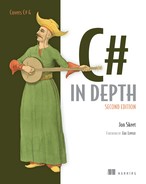Part 2. C# 2: Solving the Issues of C# 1
In part 1 we took a quick look at a few of the features of C# 2. Now it’s time to do the job properly. We’ll see how C# 2 fixes various problems that developers ran into when using C# 1, and how C# 2 makes existing features more useful by streamlining them. This is no mean feat, and life with C# 2 is much more pleasant than with C# 1.
The new features in C# 2 have a certain amount of independence. That’s not to say they’re not related at all; many of the features are based on—or at least interact with—the massive contribution that generics make to the language. But the different topics we’ll look at in the next five chapters don’t combine into one “super feature.”
The first four chapters of this part cover the biggest new features. We’ll look at the following:
- Generics— The most important new feature in C# 2 (and indeed in the CLR for .NET 2.0), generics allow type and method parameterization in terms of the types they interact with.
- Nullable types— Value types such as int and DateTime don’t have any concept of “no value present”; nullable types allow you to represent the absence of a meaningful value.
- Delegates— Although delegates haven’t changed at the CLR level, C# 2 makes them a lot easier to work with. In addition to a few simple shortcuts, the introduction of anonymous methods begins the movement toward a more functional style of programming—a trend that continues in C# 3.
- Iterators— Though using iterators has always been simple in C# with the foreach statement, it’s a pain to implement them in C# 1. The C# 2 compiler is happy to build a state machine for you behind the scenes, hiding a lot of the complexity involved.
Having covered the major, complex new features of C# 2 with a chapter dedicated to each one, chapter 7 rounds off our coverage by introducing several simpler features. Simpler doesn’t necessarily mean less useful: partial types in particular are crucial for better designer support in versions of Visual Studio from 2005 onward. The same feature is beneficial for other generated code, too. Likewise many C# developers take the ability to write a property with a public getter and a private setter for granted these days—but it was only introduced in C# 2.
When the first edition of this book was published, many developers still hadn’t used C# 2 at all. My impression in 2010 is that it’s rare to find someone who’s currently using C#, but hasn’t at least dabbled with C# 2 and probably 3. The topics covered here are fundamental to how C# 3 and 4 work; in particular, attempting to learn about LINQ without understanding generics and iterators would be tricky. If you’ve been using C# 2 and upward for a while, you may find a lot of this part covers familiar ground—but I suspect you’ll still benefit from a deeper knowledge of the details presented.
